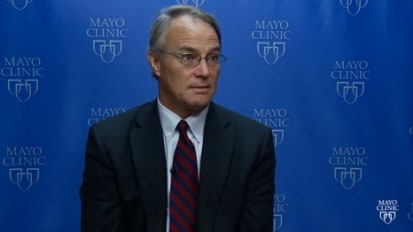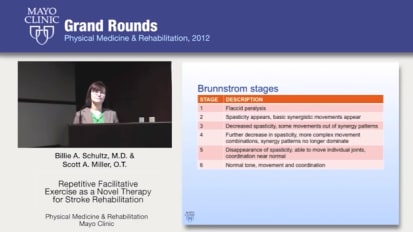Chapters
Transcript
ALLEN BROWN: The traumatic brain injury model systems are federally funded by the National Institute on Disability and Rehabilitation Research. And there are three model systems that are funded by this agency. One is a traumatic brain injury model system center, one is a spinal cord injury model system center, and one is a burn model system center. Mayo Clinic is funded just for the traumatic brain injury model system center. We've been continuously funded since 1998. So this is our fourth continuous five-year funding cycle.
There are 16 total centers that are funded around the nation-- academic medical centers that have comprehensive and subspecialty brain rehabilitation practices. And there are several things that a center needs to do if they are funded. One is all of the centers, all 16, every quarter submit data to consented subjects in their center. And the subjects are individuals that have traumatic brain injury, that have acute care at your center and inpatient rehabilitation care. So these are individuals that have, what we would call, moderate to severe traumatic brain injury, such that the severity indicates inpatient rehabilitation.
And so those subjects then have lots of data about what happened acutely to them, the severity of their injury, what happened to them during rehabilitation, and the specifics about their age and lots of demographic information. And so they consent to have this done, and then a year after they're dismissed from the hospital, then we contact them again and ask them specific and comprehensive outcome data-- specifics about are they working, who are they living with, lots of details about what their life is like now.
And then we do that again two years afterwards, and five years afterwards, and every five years and forever. And every other center does that as well. So what that has done since the data set was initiated is all the centers, every quarter, contribute this information, and so now there's over 14,000 people that are followed some 20 years since their injury.
And so what that allows us to do, in collaboration with the other centers, is to use these data and try to understand what happens over the natural history of recovery from an injury of this kind, but also to do more specific analyses about what predicts outcome, what factors are associated with their injury, or for their personal circumstances, are associated with relatively good or relatively poor outcomes.
And so that's a major thing-- that's the traumatic brain injury model system data set, and it's the largest non-proprietary data set in the world that then allows us to do that kind of longitudinal data analysis on a large group of individuals with moderate to severe traumatic brain injury. So that's one thing that we do. We all contribute to this data set and do analysis together.
The second thing is, as we've talked about before, there is site-specific research. And this funding cycle, our specific research, is a randomized clinical trial in the communities in four states. And we've talked about that before, but it's using remote technology to coordinate care after traumatic brain injury, working with individuals, their families, and their local providers to see if that kind of interaction leads to better outcomes compared to the usual and customary care that a matched group would get. And so that's our site-specific research project for this funding cycle.
Another thing that we do as a funded model system center is a site-specific research. And for this funding cycle, our site-specific research is the CONNECT trial, which is a randomized, practical, clinical trial in the communities in four states, the upper Midwest states-- Minnesota, Iowa, and North and South Dakota. And that tests a remote coordination of clinical care, including the individual with traumatic brain injury, their families, and their local providers to see if that kind of intervention improves outcome over time compared to a matched group in their communities that get usual care.
The third thing that every model system center agrees to do if they are funded is to directly collaborate with the other model system centers, and there's a process after funding where we get together and decide on what collaborative projects that we are involved with. And so various numbers of the centers, depending on their inclination and their interests and their expertise, agree to do specific, what are known as, module studies.
This funding cycle-- the three module studies that we're involved with, one is an internet use study. So all the individuals in all of our centers that consent, in addition to the one and two and five year questions that we normally ask, we also ask them some additional questions about how much internet do they use, how accessible is internet, and other kinds of media sources are available to them, and how much do they use it, how difficult it is, and things like that.
Because we have access to all these individuals uniquely in the nation, we'll be able to report what's the state of things in this cohort. To gain knowledge about this specific cohort, this specific population of individuals-- is it high. Is that a reasonable way to go as far as trying to access them to help with clinical care, or to help with accessing resources, or things like that. If it's very low, well then that's important to know because there might be ways for us to increase that access or maybe that's not the way to try to provide those services.
So that's one. So there's seven or eight centers that are involved in that project. A second one is to really look at the data that we collect, and to make certain that when we collect it, it's consistent from one time to the next. It's basically sort of validating this bank of questions. So we're asking individuals-- so say, at one year call, we're asking these questions and then a week after that, we call them again and ask them the same questions and see if their answers are consistent with the first one to find out if the data that we get are as good as we think it is. And if not, we need to focus on that in the future.
The third module project that we're involved with has to do with what's known as resilience. And there are very good clinical measures of resilience that we're using, again, when we contact individuals after they leave our practices. And in addition to the questions that we already asked them, we ask them additional questions that are essentially part of a questionnaire that measures resilience.
And resilience is essentially your outlook on life and how you view things when you are faced with a problem or difficulties, and these measures come up with sort of a quantification of that. And that's something that really hasn't been fully explored in this literature. And so seven or eight of the centers, including us, are involved in that module project too.
So those are the three main things that if you're funded as a traumatic brain injury model system center, you essentially agree to and pledge to be involved with-- contributing to the longitudinal data set, the second is site-specific research, and the third is to be involved in module projects.
Now that's just sort of the beginning quite frankly, because then beyond that, the National Institute on Disability and Rehabilitation Research has other connections with, for example, the VA, Veterans Administration, also with the Department of Defense, and with the Center for Disease Control. And so there's other intergovernmental connections.
We, as I say, the model systems are involved in, for example, trying to come up with-- because we all get data. And so especially because we're all funded by the federal government, it would be nice that these data can be shared. And to do so, they have to be, if not precisely the same data points, they have to be able to be cross-walked and converted one to the other.
And even beyond the government then using the data that we're getting, to be able to compare with data that large data sets, for example, in Europe and around the world because ultimately, it's the large numbers of individuals with similar or specifically the same data that really becomes powerful in trying to understand global trends in injury, traumatic brain injury in particular, and really getting a handle on what's happening globally.
I've been asked to be involved with the project called the global burden of disease related to traumatic brain injury. It's funded by the Bill and Melinda Gates Foundation. And that brings together existing data sets, mostly demographic and government-based data sets to try to do just that. How many traumatic brain injuries occur around the world? That's a huge project. And that's just one tiny bit of all diseases that this organization is trying to understand.
Exclusive of the model systems, that's just what we've been asked to be involved with, in addition. Ultimately, our practice uses these research data to inform clinical practice. That's why we have designed, for example, previous funding cycle of our model system center and this funding cycle. We've designed them to occur in the community so that we are testing interventions, if you will-- clinical interventions in the community where these individuals live, as they're living them, including their families and their local providers.
So that if we can design the studies rigorously and have the intervention compared to a matched group that doesn't get this intervention, then those results can be used right away. For example, in the CONNECT trial, if we find that remotely coordinated care leads to better outcomes compared to individuals that have a usual and customary care, then we can use that information right away. We can change our clinical practice, and knowing that we now have evidence showing that that kind of care is better than usual customary care.
And that's really how we focus our research efforts primarily, is to spend the effort to find out what we can translate right now to clinical practice. It's, of course, different from basic research that, of course, needs many more iterative steps after a fundamental finding to actually get to clinical care. Of course, that's incredibly important as well. Our research is focused on getting information, getting evidence to support changes in clinical practice that we can put in place right when we find out.
We have put quite a bit of effort, and thanks to [INAUDIBLE] quite a bit of money into and really fully supported by Mayo Clinic because without the resources and experience of Mayo Clinic, specifically as it relates to remotely connecting with individuals, the CONNECT trial, I think, has the potential to really influence how clinical care is provided, specifically related to traumatic brain injury.
Individuals, for example, elderly individuals, individuals in remote areas really tend to get isolated. And outside of larger medical centers, the clinical expertise is uncommonly present to sort of comprehensively manage the complicated problems associated with traumatic brain injury. When brain function has been altered by injury or disease, that affects every aspect of life. Outcomes are, I think, most effectively influenced by an experienced team of rehabilitation clinicians.
And so I believe that regardless of the outcomes of this, we will get lots of data about what works and what doesn't work. And it really, I think, has the potential to increase the capacity of the medical system to provide these services and then importantly, the individual's access to them. And by having at least a capability of a remotely coordinated component of care, that will really do a lot to increase capacity and access.
Allen W. Brown, M.D., associate professor of PM&R at Mayo Clinic, discusses traumatic brain injury model systems and data.
Related Videos

